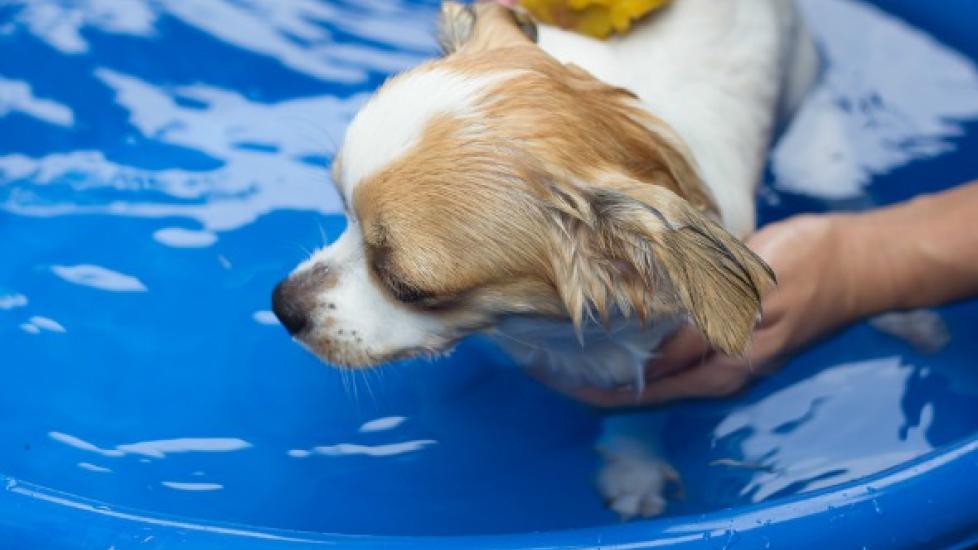Splish Splash: How to Give Your Dog a Bath
By Carol McCarthy
You can’t always tell if your dog needs a bath just by looking at him, but one whiff usually does the trick. Before you toss funky Fido in the tub, consider that bathing your dog at home requires some preparation, some knowledge and some risk of getting wet. Here is what you need to know.
Basics of Bathing Your Dog
First, consider your dog’s size and breed, says Gina Fera, owner of Perfect Paws Pet Grooming in Wakefield, Rhode Island and a certified member of the National Dog Groomers Association of America. “Say you have a German shepherd that sheds like crazy. Some people don’t want that mess in their house, so wash him outside.”
For serious shedders, large dogs or dogs with heavy coats, use the garden hose if the weather is warm enough. Smaller dogs or those that aren’t major shedders, such as Boxers, are better candidates for indoor bathing, Fera said.
Dr. Neil Marrinan of the Old Lyme Veterinary Hospital in Old Lyme, Connecticut, agrees that bathing your dog with either a hose or showerhead is fine as long as you keep water pressure low. “High pressure can drive bacteria into skin,” he said.
When bathing indoors, use water that is at least lukewarm, particularly for small dogs that chill easily. Cool water is fine in warm weather, for dogs with heavy coats or for ones that enjoy jumping in an icy pond.
Before you start running the water, get your dog’s coat clean and tangle-free with a good brushing. “A big mistake a lot of people make is not brushing their dog,” Fera said. Whatever type of dog you have, brush his coat before and after the bath, otherwise his coat will mat. If your dog will sit still or is small enough to keep a hand on while bathing, there is no need to restrain him, but if he’s likely to bolt, it is okay to tether him. Your dog should never be left in the bath unattended.
Once your dog has been shampooed, be sure to finish with a thorough rinsing to remove soap from your dog’s skin, as even a small amount of residual shampoo on the skin could develop into contact dermatitis and pruritic (itchy), moist and infected lesions called “hot spots.” Some veterinarians recommend rinsing twice as long as you think is necessary.
Health Reasons for Bathing Your Dog
Although some short haired dogs seldom need a bath, most dogs benefit from occasional bathing and this becomes an aspect of good hygiene. Bathing can can soothe sensitive skin, which is common in dogs, Marrinan said. Up to half of Labrador Retrievers can have allergic skin and most Golden Retrievers develop hot spots at some point, he added. A bath is also effective in treating dogs infected with MRSI, an antibiotic-resistant bacterial infection similar to MRSA in humans. This infection increasingly common and bathing may be part of the first line of treatment ahead of antibiotics, Marrinan said. Be sure to consult your veterinarian regarding protecting yourself against potential human contagion if a resistant bacterial infection is present for which bathing is prescribed as part of the therapy.
Do not use bathing as a home remedy to treat skin conditions. If your dog’s skin is red or itchy, has dry or wet patches or if he is losing hair, see a veterinarian for diagnosis, he said.
How Often Should You Bathe Your Dog?
Bathing frequency depends on how dirty your dog gets. Anywhere from once a month to a few times a year is typical. Dogs with skin disease can benefit from regular bathing with anti-microbial shampoo, Marrinan says. However, too much bathing will degrease and remove skin oil, making your dog itchy and causing skin breakdowns. If your dog is a swimmer, always hose him off after he takes a dip, as dirt, sand and salt can irritate his skin.
Fera says pet parents should follow a simple rule rather than a rigid schedule: “Whenever they get stinky, wash them.”
What Can I Wash My Dog With?
When it comes to choosing a soap to bathe your dog with, don’t use your favorite shampoo; use only pet-specific brands. Human shampoo is a poor choice because formulated for human hair, which is different from dog hair, Dr. Marrinan said.
Fera recommends staying away from inexpensive shampoos, as they may be poor-quality. The best way to choose your dog’s shampoo is to get a recommendation from your groomer or vet, buy shampoo only from your groomer or at a quality pet supply store and follow label directions. Always store shampoo in a clean location and toss old bottles. “Old or contaminated shampoo can cause infection if the skin gets damaged,” Marrinan said.
Tips for Drying Your Dog after Bathing
Whether bathing your dog indoors or out, dry him right away with a towel, otherwise he will immediately start rolling on the ground or floor. “Rolling is a way of drying themselves. Towel dry, and then take him for a walk,” Fera said. If the weather is bad, crate him so he cannot roll around. Dogs with heavy coats or double coats, like Golden Retrievers, should be dried vigorously to prevent damp spots in the undercoat that can turn into hot spots, Fera said.
When it comes to giving your dog a bath at home, drying is one area where your groomer has the edge with a professional-grade, high-velocity dryer that blows out the undercoat.
